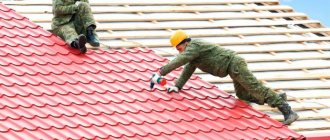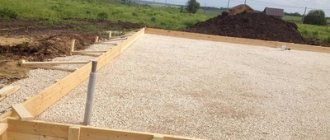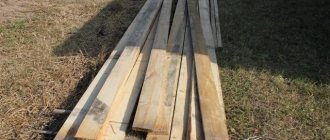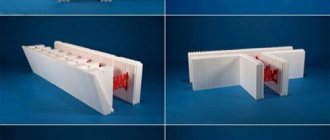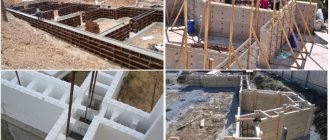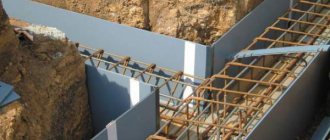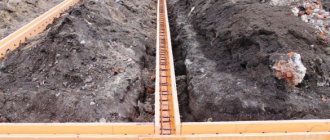If you follow construction standards and follow the sequence of technological processes, then the work can be done on your own and with minimal costs for building materials.
We will tell you in the article how and from what materials to make formwork for a strip foundation with your own hands.
What role does design play?
This is a special structure installed around the perimeter of the trench , which serves as a form for the concrete base and helps to achieve the exact dimensions of the foundation.
When pouring the solution, its walls are subjected to significant loads, so special requirements are placed on their strength. The geometric shape of the formwork must fully correspond to the dimensions of the monolithic base and have precise angles.
It is important for the builder to ensure that there are no cracks or gaps in the walls being erected. Even small holes will expand under intense load and the mixture will begin to flow out. Thus, voids are formed in the foundation mass, which reduce its performance characteristics.
Features of different types of structures
There are removable - removed after hardening - and permanent formwork.
Removable formwork for foundation
This name refers to auxiliary structures that are removed after the concrete mixture has gained partial strength. Removable elements consist of panels (solid or plank) and fastening and fixing elements connecting them. If reinforcement is provided (almost always for strip bases), supplies and spacers are added to the standard set to prevent contact of the reinforcement grids with the soil and the inner surface of the pouring forms.
Important: the removal of the formwork occurs before the final curing of the concrete, therefore, when carrying out further work, you should focus on the “maturation” time frame of the foundation, depending on the grade of concrete, weather conditions and the dimensions of the structural elements.
Permanent formwork
Fixed forms are considered to be pouring molds that remain in the building structure after the mixture has cured. This type of structure provides additional strength to the building, its heat, sound and waterproofing properties, and other characteristics. Typically, special blocks made of polystyrene foam, fiberboard and other materials are used as material for permanent structures.
Important: constructing a house using permanent forms significantly speeds up construction, improves the operational characteristics of the building, but at the same time increases the cost of the work.
Kinds
Traditionally, two types of construction are used - non-removable and collapsible . In the first case, the formwork remains with the foundation after the mortar hardens.
Builders save time and labor by eliminating the need for dismantling.
Collapsible formwork is more economical . Its design consists of individual elements that can be reused after the concrete has hardened.
This construction option takes more time and requires special attention from the craftsman to the tightness of the seams. Collapsible devices are convenient when working with complex foundations, as well as when constructing individual elements of structures.
How to properly assemble formwork for a strip foundation made of wood: step-by-step installation
When constructing wooden formwork, it is best to resort to using edged slabs or wide plywood. Next, from these materials it is necessary to assemble shields of the required sizes. After this, you need to arrange grooves on their outer contours to connect the elements together. All joints should be treated using sealant or polyurethane foam. The moisture content of the wood used should not be high. The height of the panels made should not exceed the level of the foundation strip by more than 50-70 mm. After carrying out the preparatory work and acquiring the necessary materials, you can begin constructing the formwork itself. Actions must be performed as follows:
- First of all, it is necessary to install ready-made panels on the outside of the trench and strengthen them with braces, where the main fixing component is soil or reinforced pillars. Afterwards, it is necessary to nail the braces to the boards, and then install them, maintaining a step of at least 1 m between them. The minimum permissible distance reaches 30 cm for thick bases.
- At the next stage, using nails or corners, it is necessary to fix the jumpers of a fixed length. Their maximum length should not exceed the width of the base tape being constructed.
- In the same way, you should install the inner part of the formwork and tighten it using clamps, nails or other fasteners.
- Then you need to make sure that all the boards are placed vertically and horizontally. A slope angle of no more than 3° is allowed. In addition, they should have no bends or bends. The adjustment of the panels must be done using slats, a level or a construction hydraulic level. For plywood, permissible deviations can reach 0.2 cm, and for wooden boards - up to 0.3 cm.
- Then you can prepare and pour the concrete solution. After it has completely hardened, the formwork can be dismantled, which can be reused if necessary.
Note! Before pouring the concrete solution, you need to make passages for communications, for which round sleeves are used.
The correct placement of the structure's panels can also be adjusted using casting threads and wires, as well as fixed fasteners. Giving preference to non-removable formwork, it is recommended to fix wooden planks on the inside of the polystyrene foam, into which it is necessary to install strong hooks and connect the reinforcement flexibly. In this way, the hooks will tension both surfaces of the formwork and secure them in the required position.
Upon completion of installation, the inside of the structure must be covered in several layers with roofing felt, which prevents the concrete solution from leaking out, and also ensures waterproofing of the tape. The waterproofing material must be laid from downward slopes near the sand cushion, thereby avoiding rupture of the coating during the process of pouring the mixture. It is best to bend the upper part of the roofing material over the upper edge of the formwork and secure it with clamps, screws or a stapler. In this case, the sheet is able to withstand the load that occurs when pouring concrete mortar from an automobile concrete mixer.
What can it be made from?
It is easier for a builder to use ready-made collapsible formwork, but it is much cheaper to make it yourself from scrap materials. Racks can be made of the following materials:
- Tree. The most affordable option for self-construction. Wooden panels have such advantages as aesthetics and reliability. They are well processed and fastened using ordinary tools.
- Metal. Sheets made of carbide metal are characterized by strength, help to achieve an equal concrete surface and further strengthen the foundation.
- Plastic. Panels made of polypropylene are used as collapsible formwork elements. This material is lightweight and easy to use.
- Available materials . You can use slate or corrugated sheets that were left over from previous construction projects. But it will be difficult for the worker to achieve accurate geometry and there remains a risk of the solution leaking through the cracks.
For non-removable you can use:
- metal;
- reinforced concrete blocks;
- plywood;
- wood concrete;
- DSP;
- profiled sheet;
- expanded polystyrene;
- glass magnesite.
Which board should I use?
Experts recommend using cheap boards as the main material for formwork for work without the involvement of a construction team. This is an affordable building material that is not difficult to work with without having special equipment at hand.
However, the builder needs to take into account the requirements for wooden panels:
the type of wood is selected taking into account the humidity, which should be at least 22% (for example, conifers);- recommended board sizes: width – 15 cm, thickness – from 4 to 5 cm;
- the permissible size of the cracks is up to 2 mm (it is permissible to moisten the boards before pouring to swell and reduce the cracks);
- the wood surface must be free of any defects (knots, breaks);
- At least one side of the board should be smooth and have clean edges.
Compliance of the characteristics of the source material with the given recommendations guarantees that the boards will be able to withstand at least 15 pouring cycles if the technology is followed. Collapsible formwork elements made of chipboard, fiberboard and plywood can be used up to 30 times.
Reusable laminated plywood formwork
Non-factory reusable formwork can be made from thick (from 18 mm) laminated plywood. Use timber as a frame or even do without it at all, fastening the opposite walls of the panels together with studs with nuts and washers (if the formwork is low). The material has many advantages:
• with careful use it lasts a long time; • not afraid of contact with concrete; • when properly secured, it does not deform from the pressure of the mixture; • any shape can be obtained by cutting.
The disadvantage is the same - the cost, which starts at about 1800 rubles per sheet. However, in this case, you can’t stand up for the price. For example, when pouring a floor slab or balcony platform yourself, it is difficult to obtain good geometry from below. Installation of laminated plywood supported by spacers is ideal in this case. If it is possible to pour concrete in several stages, then by calculating the maximum number of sheets required at one time, you can save a lot.
I recommend: Question: What sizes of floor slabs can be used for openings 6300 and 3920?
If there is a lot of concrete work to be done on the site, then laminated plywood is worth taking a closer look at: it is possible that such adjustable formwork will more than recoup its price. And if, after construction is completed, you sell it to a neighbor...
Advance paynemt
It is not difficult to independently calculate the required number of boards . It is more convenient to have a prepared drawing with exact dimensions. Calculations are carried out for each side of the formwork separately, and then added together.
To calculate the number of units of building material on one side horizontally, you need to divide the length of the tape by the length of the board. To calculate the amount of material in height, you need to divide the depth of the foundation by the width of the board.
At this stage, the builder needs to take into account that the panels should be slightly higher than the depth of the foundation, so the resulting value is rounded up.
The results of the two calculations are multiplied and the answer reflects the required amount of building material on one side of the foundation. Experts recommend having a supply of boards equal to approximately 10% of the calculated data.
To simplify calculations, you can use online calculators at construction services.
Auxiliary materials and working tools
To build formwork with your own hands, the builder will need:
- fasteners (nails, screws);
- beams for assembly and selections;
- waterproofing film;
- working tools (level, saw, axe, hammer, chisel and others).
The purchase of auxiliary materials for the builder will cost approximately 40-50% of the cost of the boards.
Manufacturing and installation
The whole process can be divided into several key stages:
- Preparatory – calculations and purchase of building materials.
- Transition to field work - marking the site and digging a trench according to the specified parameters.
- Production of blanks for panels (if it is not stamped material for formwork).
- Driving support beams into the ground.
- Installation of dampers.
- Strengthening.
Shield assembly
The size of the dampers is chosen taking into account the geometric shape of the base so that their height is greater than the depth of the concrete pad. The length of the elements is chosen arbitrarily, but the optimal value is considered to be no more than 3 m. The total length of the dampers must correspond to the length of the tape.
Shields can be a prefabricated structure made of boards. Fixing bars are attached across the boards in increments of 50-80 cm. The central and outer bars can be longer than the height of the formwork and have pointed ends that will go into the ground.
Installation Features
The finished dampers are installed according to the markings strictly in a vertical plane. For convenience, you can drive in vertical beams along the perimeter of the base in advance and align the walls of the formwork closely to them.
The worker must ensure that the elements fit tightly so that concrete does not flow out through the cracks . Armed with a level and a hammer, he needs to align all the shields exactly in the same plane and at the same height.
If the shields do not have long bars that could go into the ground and hold the structure, then vertical bars are first placed along the perimeter of the trench. These elements will serve as support for the shields, which must be tightly attached to them using spacers and slopes.
Strengthening
The walls of the formwork are subjected to heavy loads during concrete pouring and may fall apart. To prevent this from happening, additional elements are installed to strengthen the structure.
From the outside, the walls are supported by braces and supports . They are placed in increments of no less than 1 m. Particular attention is paid to the corners of the formwork, where support is needed on both sides at once. If the height of the shields is more than 2 m, then the supports are placed around the perimeter in two rows: upper and lower.
Plastic formwork
General description of plastic formwork
Reusable plastic formwork is a prefabricated modular system and is used to give monolithic structures the necessary geometric shapes. The design of plastic formwork for monolithic construction is dismountable and removable, consisting of plastic panels and component elements. The system is the best option for the construction of monolithic structures in cramped conditions and in the absence of lifting mechanisms.
Elements of plastic reusable formwork
Plastic formwork panels (elastic panels) are formative elements and provide the necessary shape of a monolithic structure. The panels are made from composite plastic - polypropylene. The polymer is characterized by fairly high strength, practicality and is light in weight (maximum weight of the shield is 11 kg). Shields are divided into several types:
- linear panels – straight sections;
- elements of internal and external corners - right angles of structures;
- elements of square columns - columns of square and rectangular shapes;
- elements of round columns - round columns.
Plastic wall formwork panels:
panel view height x panel width (m) area (m²) Weight, kg) linear shield 0.6 x 0.20 0,12 2,3 linear shield 0.6 x 0.25 0,15 2,5 linear shield 0.6 x 0.30 0,18 2,7 linear shield 0.6 x 0.40 0,24 3,6 linear main shield 0.6 x 1.20 0,72 11,0 outer corner shield 0.6 x 0.30 x 0.30 0,18 3,6 inner corner shield 0.6 x 0.33 x 0.25 0,15 2,9
Plastic formwork components are necessary for maintaining, adjusting and fastening formwork panels. The elements ensure the reliability of structures, the ability to install and dismantle equipment, as well as the safe conduct of monolithic work at all stages of construction.
| Line shields | Corner shields | Handle lock | Polymer nut |
Advantages and disadvantages of plastic formwork
Characteristics of plastic (polymer) formwork for monolithic construction
Compared to other formwork systems, they have their own distinctive features, advantages and disadvantages:
- high wear resistance of polypropylene;
- minimal adhesion of the polymer to concrete, which allows the system to be operated without formwork lubricant;
- polypropylene resistance to rotting and corrosion, absolute inertness to moisture;
- lightness of design - no need to use a lifting mechanism;
- constancy of shape under local mechanical influences
- simplicity of the operation process and high speed of installation and dismantling;
- possibility of use in horizontal and vertical planes;
- high quality concrete surface;
- the need to preheat the panels in winter conditions;
- no special storage requirements.
Application of plastic (polymer) formwork
Modular plastic formwork is used to construct the foundation, ventilation ducts, square and round columns. Plastic formwork is also used for the construction of walls. The most widely used plastic formwork is for monolithic construction during the construction of low-rise forms and structures.
Buy plastic formwork for monolithic construction from the manufacturer
You can buy plastic formwork directly from production, or get advice on its technical characteristics by calling tel. or by sending a completed order form from the website. TITAN GROUP sells and supplies plastic formwork to all regions of the Russian Federation and guarantees that the price of our products meets all the necessary technical requirements and quality required by our customers.
Experienced specialists of TITAN GROUP are always ready to calculate the formwork for you based on the project or technical specifications (TOR) and offer the optimal solution to the issue.
An individual approach to the client provides the best conditions for our customers, and the price of plastic formwork for monolithic construction from TITAN GROUP always remains affordable and the most attractive in the complex price-quality-time-service ratio.
How to assemble and install dampers from various materials?
Previously, the general algorithm for installing formwork was considered. The use of different materials for shields requires its own installation features. It is easier for a builder who does not have special equipment to build a structure from boards, plywood or polystyrene foam.
Installation of boards from boards
This option is considered one of the easiest to install and the cheapest in terms of cost . When working with boards, a craftsman can make do with ordinary woodworking tools.
When there are cracks on the surface of the source material, leakage of the solution can be prevented using a plastic film that is attached inside the system.
Ordinary boards are a popular building material for formwork and even a beginner can cope with their installation. The only drawback is the need to strengthen the structure with additional elements (ties, supports, metal pins).
Made from polystyrene foam
Expanded polystyrene is a practical and high-quality material . Ready stamped blocks serve as shields. They quickly assemble into a single structure. The elements fit into grooves and are secured with threaded ties.
Difficulties may arise at the stage of selecting sheets of expanded polystyrene, when arranging the necessary corners and curves. Before pouring the concrete mixture, a reinforced frame can be placed in the formwork. A significant drawback is the high cost of polystyrene foam.
How to install plywood correctly?
Sheets of plywood will serve as reliable walls for the formwork . The assembly of elements is not much different from the standard scheme. The master’s task is to assemble a structure that accurately replicates the geometry of the base.
To maintain the accuracy of the width of the tape along the entire perimeter, identical bars are attached between the sheets of plywood. When working with a massive foundation, experts recommend strengthening the walls with screeds.
How to assemble from polystyrene foam
In this case, the formwork cannot be dismantled, being first a mold for casting, and subsequently a layer of insulation. Ready-made blocks of extruded polystyrene foam and additional elements for them are used - jumpers, parts for longitudinal connections, etc.
All of them are commercially available and purchased in advance in the required quantity, which greatly facilitates assembly and allows you to obtain a durable and airtight outer cocoon for the concrete strip. The technology was invented quite a long time ago, but for various reasons it was not used; it is only beginning to gain popularity at the present time.
Nevertheless, the results allow us to predict good prospects for the technique.
Assembly of the formwork is simple. The blocks are connected to each other according to the principle of the designer, fixation is carried out using jumpers. The assembly process, in addition to creating a mold for pouring, combines insulation and sound insulation, which reduces the overall work time and simplifies the work in general.
The fewer operations there are, the less possibility of errors or technology violations.
The main disadvantage of the method is the high cost of polystyrene foam blocks, which increases construction costs.
This is the main factor hindering the spread of technology.
How to save money?
Laying the foundation with your own hands, in most cases, is explained by the desire of the master to save money on hiring a construction team. Therefore, it is advisable to consider additional ways to save.
Filling in layers
The use of removable formwork allows builders to reduce the cost of purchasing materials. The method involves the gradual pouring of concrete mixture .
After the solution hardens, the structure is dismantled and reassembled on another section of the tape. During the warm season, approximately 3-4 days pass between filling cycles.
Vertical division
The concreting process can be divided into stages both according to the length of the foundation and its height . When the bottom layer of the mortar has completely hardened, the cement laitance must be removed from its surface and you can begin the next cycle of formwork construction.
To make the building material last longer, the surface of the dampers can be covered with plastic film or treated with an aqueous solution of slaked lime.
How to make formwork for a foundation: step-by-step instructions
Installation of a removable structure most often takes into account its reuse. If this is not necessary, then you can purchase a non-separable polystyrene foam form. Doing this work on your own is quite difficult. To do this, you need to draw up a competent project and strictly follow the instructions for organizing the base formwork. Let's look at each stage of the work in more detail.
First of all, it is necessary to make shields, which are the main forming elements. Nails are used for fastening. The height of the shields should be slightly higher than that of the base (about 10 cm). In order to understand the features of assembling the forming structure, it is recommended to study the corresponding photos and videos. The formwork for the foundation is strengthened with your own hands using wooden stakes. As mentioned above, their pitch is approximately 70-100 cm. The distance from the foundation to the stakes should be approximately 1 meter.
Next, you need to place the shields along the edges of the ditch and connect them to the stakes, using special jumpers. Then the fence is leveled in a vertical plane, for which you will need to use a building level. After this, the structure is fixed to the mow.
At the next stage, the internal cavity of the formwork is covered with dense polyethylene film. The edges of the canvas are fixed using a construction stapler. Next, you will need to place a reinforcing grid in the intermediate space. When installing formwork for a strip foundation with your own hands, you may need to add wooden supports under the reinforcement, the height of which is 5 cm.
After laying the reinforcing grid, the plywood panels should be tightened using wire. It is worth noting that if the foundation has rounded areas, then in this case you will need to bend the plywood to achieve the desired shape.
Turnkey price
To evaluate the benefits of self-construction, the master should have an idea of the average market cost of the service in Russia:
| City | Cost of laying 1 m3 of formwork |
| Moscow | 1000-1200 |
| Saint Petersburg | 1000-1200 |
| Ekaterinburg | 600-1100 |
| Novosibirsk | 600-900 |
| Nizhny Novgorod | 500-800 |
How to further strengthen it?
When it is necessary to pour a large amount of concrete mixture, the system is reinforced with metal pins.
Sometimes the walls of the formwork can split apart under the weight of the solution. In this case, it is advisable to install screeds along the top of the structure .
To fix the shields, the walls are supported with beams in one or two rows, depending on the depth of the concrete base. The foundation will be stronger if wooden pegs or reinforcing rods are driven into the ground around the entire perimeter at intervals of at least 0.4 m.
Installation of other types of formwork
The foundation is not only of the strip type. There are many other types of bases. In private housing construction, columnar foundations and solid foundations in the form of a slab are common.
Columnar foundation
Columnar base formwork can be made of wood and metal. Asbestos-cement and plastic pipes are also used for permanent structures. The temporary structure is most often made of wood.
For self-production, the most suitable board is 40 mm thick and 15 cm to 20 cm wide. The boards are attached to a wooden frame made of bars. The formwork is formed in the form of a box, convenient for pouring mortar. In the most vulnerable places on the sides of the box, supports are installed to withstand the pressure of the liquid solution. After it hardens, a strong columnar foundation is created, and the boards are dismantled.
Formwork for slab foundation
As a foundation, structures in the form of a monolithic slab base are used. This type of construction is performed with mandatory mortar reinforcement, which prevents the concrete monolith from cracking during hardening. The slab is mounted on a sand cushion.
Formwork, formed in the form of panels, is placed along the entire perimeter of the site for the foundation. Supports are installed on the outside.
The slab foundation design, designed to withstand significant loads, is used in the construction of buildings with more than one floor.
When to shoot, after how many days?
Dismantling of the structure is possible only after the solution has completely turned into a solid mass . The duration of the process is determined by the massiveness of the foundation, its depth, the grade of concrete, and the ambient temperature.
Under suitable weather conditions, foundations for heavy structures require up to 4 weeks to fully cure. For private housing construction, demoulding can be done after 20 days.
After dismantling, gaps may remain on the surface of the base. These defects are filled with soil or filled with cement mortar.

